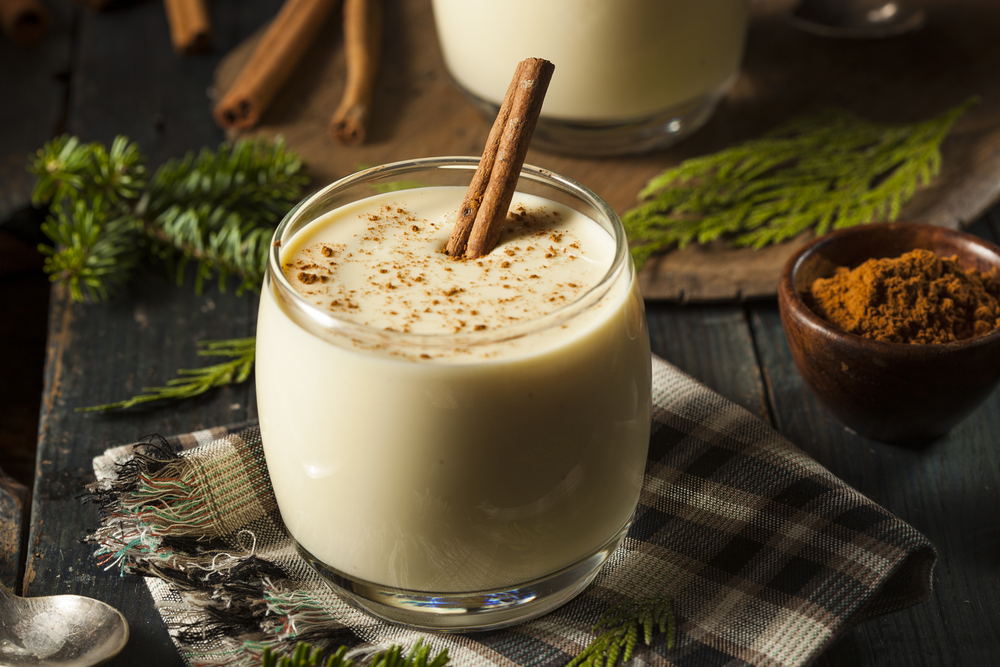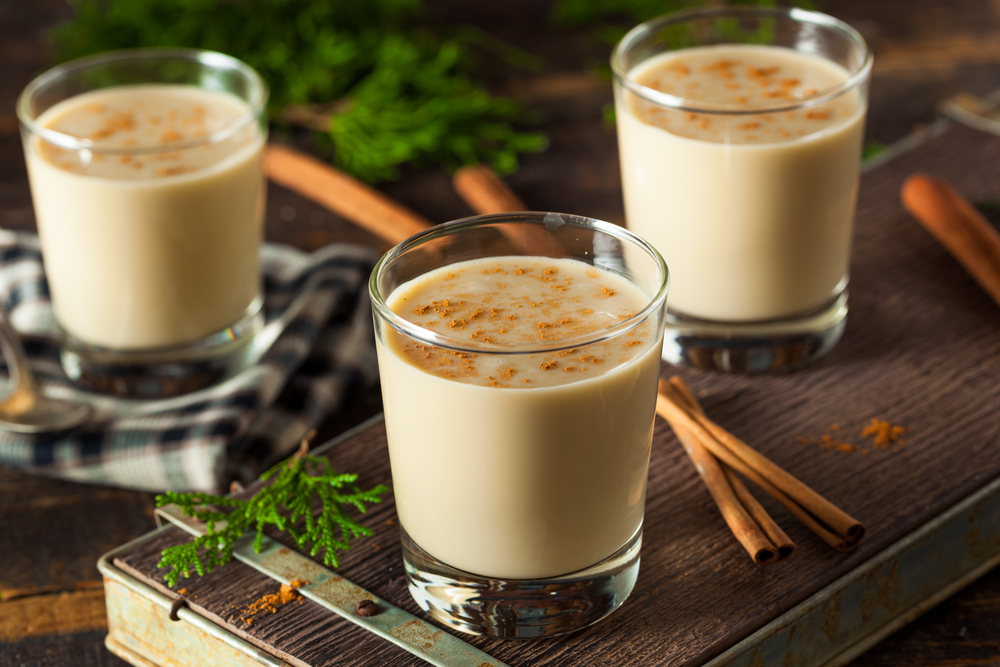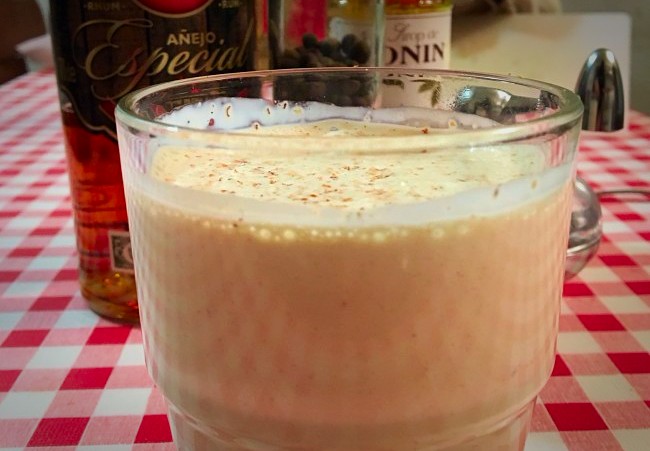It’s that time of year again, when folks start dishing up the most controversial of all seasonal arrivals: eggnog. When it comes this yolky, spicy, satiny drink, there isn’t much middle ground. Some people are appalled by the richness, while others (myself included) can’t get enough of the stuff.
There’s an old adage about eggnog that if you’ve only tried the store-bought variety, you’ve never really had it at all. We tend to agree. Commercial eggnog has to contain no less than one percent egg and its makers often amp the sugar up to extremes to create flavor.
This holiday, we want you to give the nog another shot by making, or just partaking, in the real thing.
WHAT THE HELL IS EGGNOG ANYWAY?

Eggnog goes back centuries. The English used to mix milk, eggs, spices, and ale into a hot drink and use it as a medicine, commonly called a posset. As time went on, that concoction took on variations as Europeans spread across the new world. Eggnog, as we know it today, was more or less invented in the American colonies where access to chickens, cows, and rum brought together the three key ingredients.
Eggnog was the signature drink of the Christmas season by the time the American Revolution rolled around. Noted bacchanalian George Washington kept a vat of the stuff on hand during the holidays. His recipe is pretty close to what you’d get to this day.
One quart cream, one quart milk, one dozen tablespoons sugar, one pint brandy, 1/2 pint rye whiskey, 1/2 pint Jamaica rum, 1/4 pint sherry—mix liquor first, then separate [a dozen] yolks and whites of eggs, add sugar to beaten yolks, mix well. Add milk and cream, slowly beating. Beat whites of eggs until stiff and fold slowly into mixture. Let set in cool place for several days. Taste frequently.
As the recipe indicates, eggnog was a massively popular drink in early American history, so much so that black-out drunken culture sprouted around the imbibing of the drink — proving that even our ancestors need to get hammered to get through the holidays. “In 19th-century Baltimore, it was a custom for young men of the town to go from house to house on New Year’s Day, toasting their hosts in eggnog along the way. The challenge: to finish one’s rounds still standing.”
In the 1820s at West Point Academy The Eggnog Riot — yes, riot — broke out when the higher-ups tried to ban alcohol from the usual eggnog preparations for the year. Two of the rioters were future Confederate States of America President Jefferson Davis and Confederate General Robert E. Lee. Eggnog was such a crucial part of the holiday season for Americans that people were willing to riot over it — let that sink in for a moment.
As time marched on, and America industrialized, so did eggnog. As with too many of our food products, the FDA allowed eggnog to be adulterated for cheap and fast reproduction and distribution. This led to a glut of inferior products swamping the market full of “modified milk ingredients, glucose-fructose, water, carrageenan, guar gum, natural and artificial flavorings, spices, monoglycerides, and colorings.”
So, we really can’t blame you if you tried commercial eggnog and didn’t like it much. We counter that the original is a really straight-forward and blissful recipe that warms the cockles of your very soul.
STORE-BOUGHT VS. HOMEMADE

Store-bought eggnog can be good. Local dairies are releasing their own nog products more and more as of late. The best tip we can recommend is finding a local dairy and supporting your local agriculture by buying your eggnog fresh from them. If you’re in a city, look for a glass bottle on your grocery store dairy case — more often than not, that version will be more or less straightforward. But don’t forget to read the ingredients list.
Eggnog only really needs to contain milk or cream, egg yolk, spices, and sugar.
https://www.instagram.com/p/BMKjST4jp5d/
If you want to make some at home and are worried about consuming raw eggs, buying commercial is probably your best bet. However, if stored properly and treated with care, consuming raw eggs is perfectly safe and delicious.
These days, making eggnog isn’t particularly labor-intensive. If you take the cocktail route, you can easily whip up some nog with or without alcohol in a matter of minutes.
Zach’s recipe for Classic Eggnog
What I do is pretty straightforward and anyone can learn with a little patience (and delicious practice). I’ve adjusted the ingredients slightly to add a little more complexity (which suits my palate) by supplementing regular sugar with hazelnut simple syrup. Otherwise, it’s the classic recipe.
You’ll need a cocktail shaker (preferably not a Boston shaker), bar spoon, chilled old-fashioned tumbler, and deeply frozen ice. In the shaker combine the following.
- One bar spoon of hazelnut simple syrup
- One large egg yolk (preferably organic and very fresh)
- A good pinch each of fresh ground allspice and cinnamon
- Three good cranks from the nutmeg mill
- 2 ounces of good, dark rum (I use Havana Club Añejo Especial)
- 4 ounces of heavy cream
Add in six large ice cubes, pop on the shaker top, and shake vigorously for 30 seconds. It’s crucial that you give it all you’ve got. You need the cream, alcohol, and egg to emulsify completely.
Strain the eggnog into your pre-chilled old-fashioned tumbler and garnish with one or two cranks from the nutmeg mill. That’s it.

If you want to make a virgin version of this, simply replace the rum with another two ounces of cream. That’s what I do for my kids, and they love it.
You can also supplement the rum with rye, bourbon, brandy, or even sherry. The classic Waldorf Astoria version calls for tawny port and bourbon, but that’s more an acquired taste and takes a very gentle shaking so that the port doesn’t overpower the cream and yolk emulsion. Our advice is to play around with the recipe and make it your own. Good luck!







